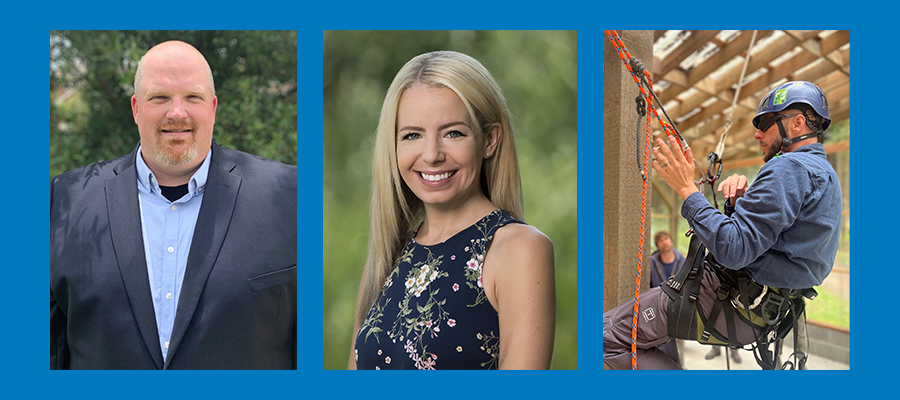- Vegetation Management Services
- Industries
- In Your Neighborhood
- About
- Careers
- Webinars
- Articles
Take Responsibility While on the Road: Drive Distraction-Free

Take Responsibility While on the Road: Drive Distraction-Free
By Kaiden Grossi, fleet manager, ACRT Services
Imagine someone asking you to blindfold yourself, then drive the entire length of a football field at 55 m.p.h. That would seem like a wild request, right? Sending or reading a text while driving takes your eyes off the road for five seconds — the same amount of time it would take a person to drive from one end of a football field to the other.
According to the National Highway Traffic Safety Administration (NHTSA), distracted driving claimed the lives of 3,142 people in 2020 alone.
Every year, the NHTSA recognizes April as Distracted Driving Awareness Month — a time to “regroup and take responsibility for the choices we make when we’re on the road.”
The NHTSA defines distracted driving as “any activity that diverts attention from driving, including talking or texting on your phone, eating and drinking, talking to people in your vehicle, fiddling with the stereo, entertainment or navigation system — anything that takes your attention away from the task of safe driving”.
The National Conference of State Legislatures (NCSL) estimates “more than 220 million people in the United States subscribe to wireless services, and it is estimated that as many as 80% of those subscribers use their phones while driving.”
In addition to the “standard” interruptions, the number of distractions while driving seems to multiply every day. Think about the advancements of our mobile devices and interactive billboards and signs we see while behind the wheel.
Hands on the wheel, eyes on the road
In 2022, our ACRT Services family of companies’ employees drove more than 25 million miles. It’s incredibly important that our fleet department consider the other variables related to our industry.
Weather patterns. It’s important to monitor the weather for current and past travels by employees. For example, someone driving in Arizona might be less familiar with operating their windshield wipers due to the minimal annual rainfall and become distracted, versus someone in Ohio who likely activates their wipers regularly due to rain and snow.
Traffic patterns. Certain times of day may require different travel patterns. Think about people going to and leaving work. Think about school zones. Think about local happenings.
Driving location. Depending on the type of work and location, not all driving takes place on a street. A lot of traveling in our industry takes place off the highway on right-of-ways (ROWs) — especially when workers are trying to locate other vendors and tree crews, looking at maps, trying to find locations, and so on.
Infrastructure growth. We’re seeing expansive growth of infrastructure in different areas throughout the country. I’ve spent a lot of time in Greenville, S.C., and have watched the infrastructure boom over the past few years. This growth leads to new construction, highways, and roads — conditions that are out of our control and can distract drivers at a moment’s notice.
So, what can we do to prevent distracted driving? The Federal Communications Commission (FCC) suggests taking the following precautions.
Be clear. Make sure employees understand that they should not use wireless devices while driving. Discuss how taking their eyes off the road – even for a few seconds – could cause someone injury or even death. Your brain is distracted for 27 seconds after a call or text, so red lights and stop signs are not the time to use a device.
Lead by example. Set rules for drivers, and yourself, regarding distracted driving. Never text while driving – if you are driving and you need to text or talk on the phone, pull over to a safe place before doing so.
Be engaged. Talk to your peers about the importance of driving without distractions.
Making focused driving a priority
Many causes of incidents are considered preventable. With some simple safety measures and tips to follow, you can help ensure your team members make it home to their families each night. At ACRT Services, we recommend several safety solutions, including a three-second safety cushion while driving. By creating a three-second space between you and the vehicle in front of you, you will have more time to react if the car in front of you suddenly stops or swerves.
From the fleet management perspective, we’re also working to curb distracted driving by introducing better technology, processes, and resources to encourage focused driving. With the help of telematics resources like Geotab, we can gather real-time information and identify trends faster, before they have the opportunity to become dangerous habits — enabling not only our organization but also our partners, to be more intuitive and precise.
When it comes to our utility vendors, we aren’t just a third party — we’re partners — we just have different names on our hard hats and trucks. Driving safely affects everything and everyone.
My mantra is, “Safety is a full-time job, don’t make it a part-time practice.” I stand by those words in all aspects of life, whether I’m on the road or in the office. If something gets your full attention, such as driving, you get a better product, you get to go home every night, and your company gets to keep operating.
I invite you to make safety a full-time job by taking the National Safety Council (NSC) Just Drive Pledge with me and committing to driving distraction-free this Distracted Driving Awareness Month and beyond.
This article was originally published by Landscape Business.
Related Articles

Servant Leadership in Utility Vegetation Management By C. Troy Ross, President, ACRT and ACRT Pacific On a chilly Monday morning, a utility vegetation management crew gathers for their weekly briefing. Instead of launching into instructions, their supervisor begins by asking each team member how they’re doing. One mentions a child’s illness, another shares excitement about[...]
Read More
Turning Vegetation Waste into Opportunity By Aana Agrawal, Sustainability and Resilience Manager, EnviroScience The utility vegetation management (UVM) sector plays a crucial role in ensuring the smooth transmission of power across regions and cities by keeping plant growth under control within the vicinity of transmission and distribution lines. However, unrefined vegetation maintenance practices often focus[...]
Read More
Reflections from Will Nutter Silver Shield Award Recipients By Bob Urban, Senior Manager, ACRT Services In an industry where the stakes are high and every decision can have life-altering consequences, leadership in utility arboriculture isn’t just a managerial function; it’s a calling. Nowhere is this more evident than in the recipients of the Will Nutter[...]
Read More
The Electric Butterfly: Reconnecting with Nature on the Edges By Ryan Meccage, Business Development Manager, ACRT Services In an age dominated by smartphones, constant connectivity, and algorithm-driven content, we’ve never been more digitally immersed. Yet somehow, we’ve also never felt so far removed from the natural world beneath our feet. The urge to step away[...]
Read MoreRecent Posts
- Alex Fields Awarded ACRT Safety Challenge Coin 20th Nov 2025
- Servant Leadership in Utility Vegetation Management 12th Nov 2025
- ACRT Honors Our Veterans 10th Nov 2025
- Anna Davis Awarded Safety Challenge Coin 04th Nov 2025
- ACRT Senior Consulting Utility Forester Recognized as Safety Superstar 15th Oct 2025
Categories
The Leader In Vegetation Management
We are all about people, and we put safety first. Ready to work with our well-trained team?